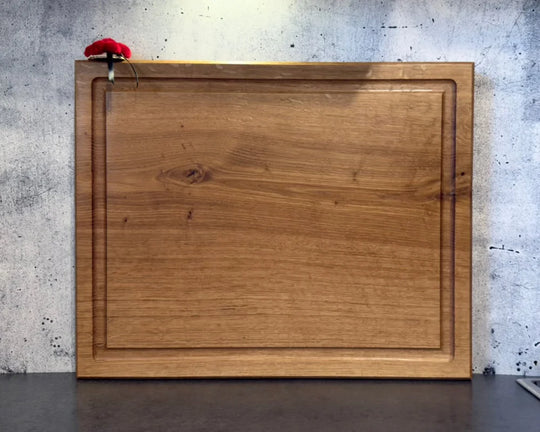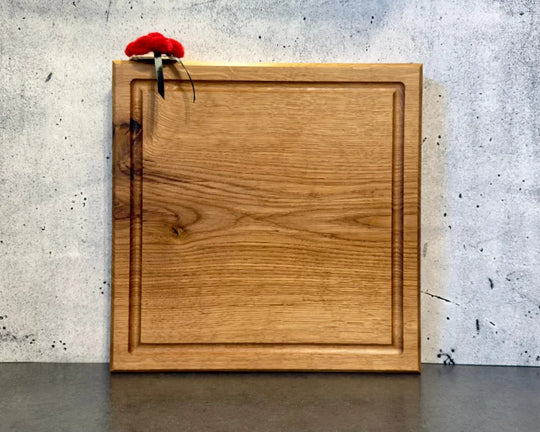Eiche ist robust, langlebig – und enthält viele Gerbsäuren (Tannine). Das ist gut für die Hygiene, führt aber manchmal zu dunklen Verfärbungen, gerade wenn Eisen im Spiel ist. Hier bekommst du die kurze Erklärung und die klaren Praxis-Schritte.
Kurzfassung
- Hygiene: Tannine wirken natürlich antimikrobiell – Eiche ist deshalb eine sehr gute Wahl für Schneidebretter.
- Schwarze Flecken? Entstehen meist durch Eisen + Gerbsäure (z. B. Stahlwolle, Guss, Carbonstahlmesser) – optisch, nicht gefährlich.
- Vermeiden: Kein Kontakt zu Eisen, wenn das Brett nass ist; direkt abtrocknen; keine chlorhaltigen Reiniger.
- Pflege: Handreinigung, gründlich trocknen, regelmäßig ölen. Bei hartnäckigen Eisenflecken: gezielt behandeln (siehe unten).
Was sind Gerbsäuren (Tannine) – und warum hat Eiche so viel davon?
Gerbsäuren sind pflanzliche Polyphenole. Eiche enthält davon vergleichsweise viel – erkennbar u. a. am typischen, leicht herben Holzgeruch. Diese Stoffe können Mikroorganismen am Wachstum hindern. In Kombination mit der natürlichen Kapillarstruktur von Holz (Feuchtigkeit wird in die Tiefe verteilt und trocknet) entsteht ein sehr hygienisches Arbeitsumfeld auf dem Brett – vorausgesetzt, du reinigst und trocknest es korrekt.
Hygiene in der Praxis: Warum Eiche punktet
- Antimikrobieller Effekt: Die Tannine stören Bakterien & Co. – ein natürlicher Bonus.
- Feuchtemanagement: Holz nimmt Oberflächenfeuchte kurz auf, verteilt sie und trocknet – Keime mögen das nicht.
- Glattes Finish: Ein gut geöltes, fein geschliffenes Brett lässt sich leicht reinigen und reduziert Anhaftungen.
Wichtig: Holz ersetzt keine Küchendisziplin. Sauberes Arbeiten, direktes Spülen, vollständiges Trocknen und regelmäßiges Ölen bleiben Pflicht.
Schwarze Flecken auf Eiche – woher kommen sie?
Tauchen dunkle bis schwarze Verfärbungen auf, liegt fast immer eine Reaktion von Eisen mit Gerbsäuren vor (Eisen-Gerbstoff-Komplex, auch „Eisen-Tannat“). Typische Auslöser:
- Kontakt mit Stahlwolle oder Stahlschwämmen beim Reinigen
- Abstellen von Gusseisen (Pfannen, Dutch Oven) auf feuchtem Brett
- Carbonstahlmesser auf nasser Eiche, Späne/Partikel im Schnittgut
- Eisenhaltiges Wasser oder Rostpartikel
Die Flecken sind nicht gefährlich und meist rein optisch. Sie sitzen in den obersten Holzfasern.
So vermeidest du Verfärbungen
- Kein Eisen auf nasser Eiche: Gusseisen, Stahlwolle & Carbonstahlmesser fernhalten, solange das Brett feucht ist.
- Nach dem Spülen abtrocknen: Wasser nicht stehen lassen; Brett hochkant mit Luftkontakt trocknen.
- Reiniger mit Bedacht: Keine chlor-/bleichmittelhaltigen Produkte; milde Seife reicht.
- Finish pflegen: Regelmäßig ölen – das reduziert das Eindringen von Feuchtigkeit und Metallionen.
Schwarze Eisenflecken entfernen – Schritt für Schritt
Kurz & mild: Für frische, kleine Flecken
- Mit warmem Wasser und etwas Handseife reinigen, abspülen.
- Fleckbereich leicht anschleifen (Korn 240), Staub entfernen.
- Dünn ölen, 12–24 h aushärten lassen, ggf. zweite dünne Schicht.
Hartnäckig: Wenn der Fleck tief sitzt
- Trockene Oberfläche – dann gezielt mit Oxalsäure (Holz-Entgrauer/„Eisenfleck-Entferner“) arbeiten. Herstellerhinweise beachten, Handschuhe tragen, nur lokal auftragen.
- Einwirken lassen, neutralisieren/abspülen, vollständig trocknen lassen.
- Faserstand fein schleifen (Korn 240–320), Staub entfernen, neu ölen.
Hinweis: Nur punktuell einsetzen und nicht zur Routine machen. Alternativ zuerst Zitronensäure versuchen – wirkt schwächer.
Reinigung & Pflege – der einfache Rhythmus
- Nach dem Schneiden: Mit Teigkarte/Spatel abziehen, warmes Wasser + etwas Handseife, kurz spülen.
- Trocknen: Sorgfältig abwischen, hochkant mit Luftzirkulation stellen.
- Gerüche/Flecken leicht: Grobes Salz + Zitronensaft kurz einreiben, abspülen, trocknen, dünn ölen.
- Ölen: Je nach Nutzung alle 2–6 Wochen dünn auftragen, 12–24 h aushärten lassen.
- Tabu: Spülmaschine, Einweichen, aggressive/bleichende Reiniger.
Pflegeprodukte findest du hier: Pflegeprodukte & Zubehör.
Wann Eiche die beste Wahl ist – und wann Alternativen sinnvoll sind
Eiche glänzt, wenn Robustheit, Standfestigkeit und Hygiene im Vordergrund stehen – etwa beim Tranchieren von großen Stücken (BBQ, Braten). Wer Wert auf möglichst wenig Reaktion mit Eisen legt oder sehr empfindlich auf optische Veränderungen reagiert, kann zu Eiche-Chefbrettern mit gepflegtem Finish greifen oder Alternativen wie Servierbretter in Nussbaum/Esche

Für BBQ-Setups mit viel Fleischsaft und Bühne fürs Anrichten: Pitmaster Board & CaterBoard.
FAQ: Gerbsäuren & Eiche
1) Sind schwarze Flecken gesundheitlich bedenklich?
Nein. Eisen-Gerbstoff-Flecken sind optische Verfärbungen. Reinige, trockne und – wenn dich der Look stört – behandle wie oben beschrieben.
2) Reagieren Lebensmittel mit Eiche?
In der Regel unkritisch. Säurehaltige Zutaten können die Farbe minimal beeinflussen. Direktes Abspülen und Trocknen reicht.
3) Darf ich Essig oder Natron verwenden?
Ja, in Maßen. Essig (mild) zur Geruchsbeseitigung ist ok. Natron gegen fettige Flecken ebenfalls. Danach immer gut abspülen und trocknen.
4) Warum riecht neue Eiche intensiver?
Frische Tannine. Das legt sich mit Gebrauch und einer stabilen Ölpflege.
5) Wie oft soll ich ölen?
Je nach Nutzung alle 2–6 Wochen. Dünn auftragen, gut aushärten lassen. Bei fühlbar trockener Oberfläche früher.






















